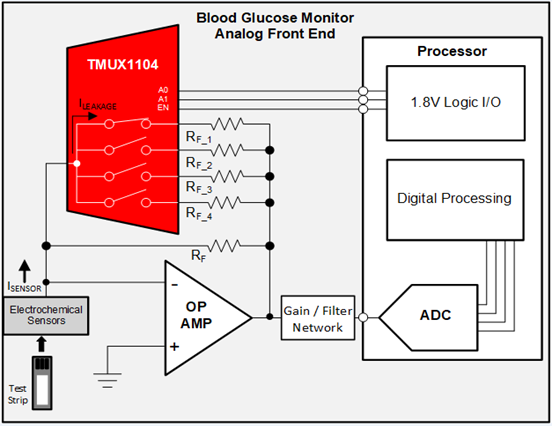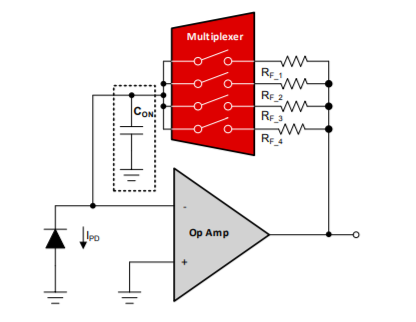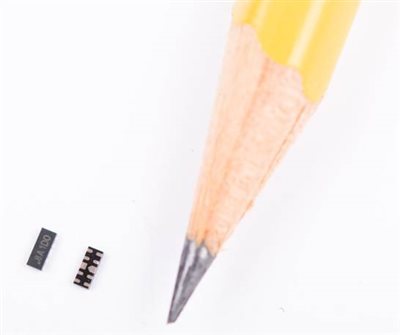SSZT539 february 2019 TMUX1104 , TMUX1111
According to World Health Organization statistics, the global prevalence of diabetes mellitus is approximately 155 million and is expected to increase to 300 million by the year 2025. Since there are serious health threats involved with high or low blood glucose levels in the body, precaution and monitoring are very important. So, you can imagine the need for millions of personal portable blood glucose monitors (BGMs).
Modern BGMs require high levels of integration in a smaller size so that they are easy to hold and carry. Their daily use also necessitates a high-performance device that can accurately measure blood glucose levels with only a small amount of blood.
Saving diabetes patients’ fingertips (from multiple measurements) is a precision multiplexer in the BGM’s sensor front end. While it may seem like the multiplexer only handles the simple job of switching between different signal channels - it actually plays an important role in the accurate measurement of the signal received from the sensor strip.
The right precision multiplexer can help engineers working on small-form-factor BGMs overcome key design challenges around current leakage, on-capacitance and size constraints. Understanding the importance of these parameters can help reduce pain and improve quality of life for engineers and diabetes patients alike.
Ultra-low Leakage Current (ILEAKAGE)
BGMs use a test strip to interact with a patient’s drop of blood, produce a chemical reaction and generate a current signal with the help of special sensor strips. This current signal is very small and usually converted into an amplified voltage signal in the transimpedance amplifier (TIA) stage. The current signal from the sensor strip is fed to the TIA with configurable gain settings before sampling by an analog-to-digital converter (ADC, usually inside a microcontroller).
 Figure 1 Precision Multiplexer Use Case in a BGM Analog Front End
Figure 1 Precision Multiplexer Use Case in a BGM Analog Front EndFigure 1 shows one channel 4:1 multiplexer switching four different feedback elements for the configurable gain of an operational amplifier (op-amp). An external resistor, RF (as shown in Figure 1), or utilizing one of the four channels always being closed, ensures that the amplifier isn`t operating in an open loop configuration. Although there are four feedback resistors shown in Figure 1, the number of resistors can be even higher or lower depending on the different gain settings required.
These gain settings are required in accordance with the current output from the test strip, which could range anywhere between 10µA to 80µA depending on the low or high blood glucose levels. The range could also be altered to measure glucose levels at different times or for different patients.
This is where a designer not only needs a low on-resistance (RON) but also an ultra-low-leakage multiplexer for better ADC accuracy.
The reason is simple: the leakage current from the multiplexer when the switch is ON, adds to the current signal from the sensor strip and flows through the feedback resistor to provide an incorrect reading at the output of the op-amp. This incorrect output voltage value is then fed to the ADC, which upon conversion into a digital signal for processing will show an inaccurate reading on the display screen.
So, in summary, the lower the on-leakage current of the multiplexer, the more accurate the reading you will get at the output.
TI has released a range of precision multiplexers that meet the ultra-low-leakage requirement. The TMUX1104 (highlighted in Figure 1) provides extremely low on-leakage (3pA-TYP and 50pA-MAX _at 25°C). The TMUX1104 is capable of switching signals from high-source-impedance inputs into a high-input-impedance op-amp with minimal offset errors because of the ultra-low-leakage currents.
Low On-capacitance (CON)
Another important parameter that impacts the performance of the multiplexer in a BGM application is the on-capacitance, CON. CON affects the settling behavior of multiplexers and thus the transient performance of the system.
Stability issues can occur in TIA circuits when the multiplexer’s CON specification is neglected. The CON of the multiplexer can cause oscillations resulting in poor transient performance of the signal chain. While system designers may not add capacitance to a design intentionally, the CON of a multiplexer may be large enough to impact the system.
Selecting a multiplexer with low CON can help minimize issues caused by these common circuit challenges. The CON of a multiplexer represents the equivalent capacitance to ground seen by the system when a multiplexer channel is conducting. Typical values of CON for analog multiplexers range from tens of picofarads (pF) to over 400pF. However, the TMUX1104 device has CON as low as 35pF.
If using a four-channel single-pole-single-throw (1:1) switch for configurable gain control, as shown in Figure 2, each individual channel has its own CON, which will be placed in parallel when all channels are conducting. Maintaining that one channel out of the four is always closed ensures the amplifier is not operating in an open-loop configuration. If a multiplexer is not selected to optimize the on-capacitance, a single channel of a 1:1 switch can typically have 70pF of capacitance. Therefore, with all four channels conducting the total CON of the feedback path would be 280pF. Conversely, using a TMUX1104 with just 35pF of CON would lead to a total feedback capacitance of only 140pF with all channels conducting.
 Figure 2 Configurable Gain Control
Figure 2 Configurable Gain ControlConsiderations for Small-size BGM
Be it a cell phone, laptop or tablet, the trend has always been to get smarter, smaller and lighter. The same applies to portable medical equipment like BGMs. Patients prefer to have a small BGM that not only gives an accurate reading but is easy to carry around. This poses a challenge for designers to find new solutions that are not only more precise but also come in a small form factor.
The TMUX11x family of precision multiplexer supports a wide operating supply (1.08-V to 5.5-V single supply or ±2.5-V dual supply) in small leaded and leadless packages. These devices have very low on-leakage current, low CON and small package options, enabling their use in portable medical applications that require high precision measurements. The TMUX1104 is one of the industry’s smallest one-channel 4:1 precision multiplexers (as shown in Figure 3). The device has ultra-low leakage current (3pA_TYP) and a low supply current of 8_nA making it a good fit for portable medical applications like battery-operated BGMs.
 Figure 3 TMUX1104DQA (10-USON
Package)
Figure 3 TMUX1104DQA (10-USON
Package)There is no need to trade off system accuracy or stability when designing a precise BGM. Just select a precision multiplexer in the sensor front end that has very low leakage current, low CON and comes in a small package.
Additional Resources
- Read Improve stability issues with Low Con Multiplexers.
- Learn more about 1.8-V Logic for Multiplexers and Signal Switches.